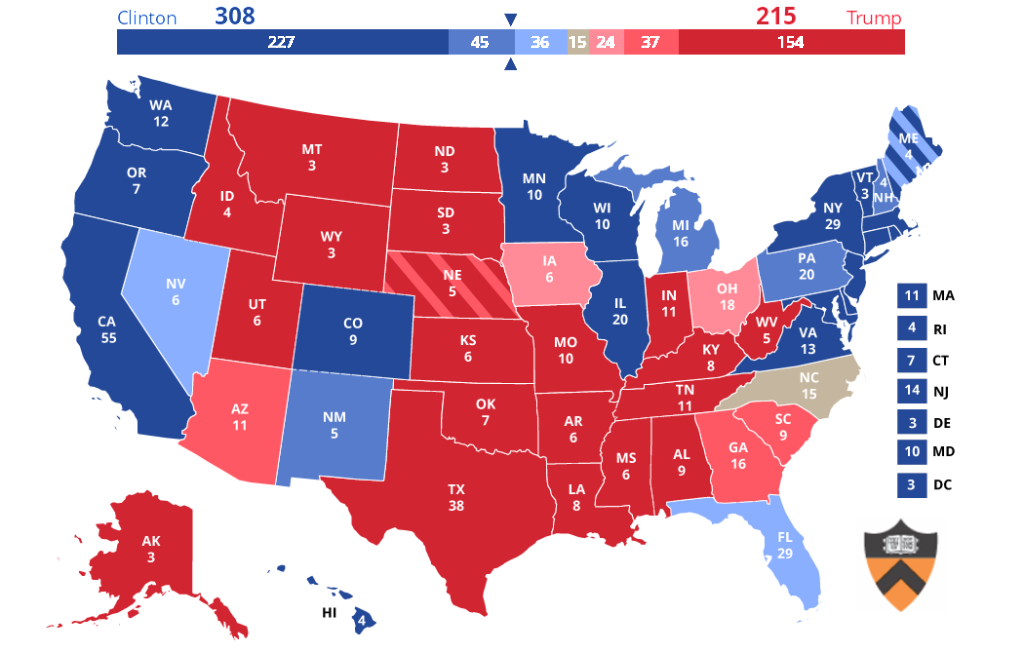Ryan Lucas of the University of Bath provides your handy guide to the US Presidential election, contested by Republican Donald Trump and Democrat Hillary Clinton.
We will update this page regularly, taking account of latest polls and developments, between now and Election Day:
See also US Audio Special: Assessing the Presidential Election…and the State of the Country
US Analysis: Why is Russia Supporting Donald Trump?
US Analysis: Your Essential Guide to the Senate Elections
EA’s Full Election Coverage
UPDATE, NOV 8: As Election Day begins, Hillary Clinton has checked Donald Trump’s rally and appears to be strengthening in her quest for the White House, although the Republican nominee still holds a tenuous “path to victory”.
To defeat Clinton, Trump must ensure he wins these six states — Utah, Arizona, Iowa, North Carolina, Ohio, and Florida.
The Republican nominee must also then win Colorado plus either Nevada or New Hampshire.
If Trump wins Nevada and New Hampshire but loses Colorado, he must then win Maine’s 2nd Congressional District and its electoral vote for a 270-268 margin. If Clinton wins the district, the 269-269 vote could force the State delegations in the House of Representatives to make a final decision.
—
In the final national and state polls, Clinton regained narrow leads in Florida and North Carolina and a slighter larger edge in Nevada.
OVer the past two weeks, Trump’s rally — aided by the FBI’s political interventino over Clinton’s e-mails — had given him a thin advantage in Florida and North Carolina.
The Republican nominee is still solid in Ohio and Iowa as well as Arizona and Utah.
However, in addition to the Florida-North Carolina-Nevada, Trump has the challenge of overcoming a significant Clinton lead in one of her final two “firewall” states.
The Republican has slipped to a 30% chance of winning New Hampshire, while Clinton is a 78% favorite in Colorado.
The scenario is still a demanding task for the Trump campaign — it has to ensure victory in each state that is almost 50-50 as well as in New Hampshire — but it is possible, compared to Clinton’s near-certain win two weeks ago.
Clinton supporters also are drawing hope from reports of heavy early voting in key states such as North Carolina, Florida, and Nevada. They believe that the initial results, including widespread participation by Latino voters, will favor the Democrat.
Clinton’s final lead in state and national polls is about 3.5%.

ORIGINAL ENTRY: On November 8, citizens across the US will vote in what has undoubtedly been the most polarized and volatile election in recent history.
But some of those citizens’ votes have more importance than others. Indeed, Donald Trump and Hillary Clinton will fighting tooth and nail for a select few states. It’s not California, New York, and Texas that will decide the next President, but the “swing” states — from the bigger prizes of Florida and Ohio to the smallest but still significant battlegrounds of New Hampshire and Maine.
So, if you are new to US elections, what are you looking for as the results begin to roll in during the early hours of Wednesday, November 9?
Understanding the Electoral Votes
In the US, the winner of the election is not decided by the popular vote. Instead, each state and the nation’s capital, the District of Columbia, is allocated a number of electoral votes in a “winner takes all” system (except for a slightly different arrangement in Maine and Nebraska, but we’ll leave that for now).
The number of electoral votes is equal to the two Senators plus the total of Representatives, which vary by population, from each State. So California has 55 votes, followed by Texas with 38, while the seven least-populated states and Washington, D.C. have only three each.
There are a total of 538 delegates in the Electoral College, so the magic number for a candidate to be assured of the White House is 270.
Most states in the USA vote for either a Republican or Democratic candidate consistently. From Day 1 of the campaign, Clinton had California’s 55 electoral votes in the bag. Likewise, Trump can count on 38 votes from Texas.
Given the voting patterns of past 40 years, Trump started off with an estimated 169 “safe” electoral votes. But those same patterns pointed to 258 electoral votes for Hillary Clinton — in other words, a starting point of just short of a majority.
So the Trumpian task? Secure his base, win all eight swing states, and — just to be sure — peel off one or two of the supposedly “safe” Clinton states, especially a larger one such as Pennsylvania or Michigan.
Trump’s Four Hurdles
1. Holding On
First, Trump has to keep all the “solid-red” states that have been Republican for decades. If Trump cannot hold on to these states, then his chances of winning the election are all but over.
That is far from assured, given Trump’s dip in the polls amid his controversial statements.
The three states to watch are Georgia (16 electoral votes), Arizona (11), and Utah (6). They should not have been of any concern for a Republican candidate, with sizable victories for Mitt Romney in all three in 2012.
Despite a wobble this summer, Georgia is not yet in danger of tipping. But Arizona — whose long-time Senator and former Presidential candidate, John McCain, has been subjected to a barrage of insults by Trump since the spring — is now close to a 50-50 call. And Utah has been thrown into the ring by the surging candidacy of the independent Evan McMullin, a conservative Mormon and former CIA officer antagonized by Trump’s actions and statements.
That’s not all. Unexpectedly, Alaska — deep-red since statehood in 1959, except for the 1964 landslide of Democrat Lyndon Johnson — is now in the balance. It only has three electoral votes, but each one now matters to Trump.
2. The 1st Swing States
Trump’s next task is to grab the states that have been closest to toss-up status since the party conventions. In a major setback, he appears to have no chance in Virginia (13). However, during his September surge in the polls, he took the lead in both Iowa (6) and North Carolina (15).
No more. Trump’s poor performances in the 1st and 2nd debates and the media spotlight on his behavior, especially towards women, have turned the polls around in both states.
Both are far from lost — Clinton is only narrowly ahead in Iowa, and is about a 2-1 favorite in North Carolina — but Trump has to make another push just to get past the second of his four barriers.
3. The Big Swing States
Florida (29) and Ohio (18) have long been the barometer of US Presidential politics. Over the past 10 elections, Ohio has voted for the winning party every time; Florida voted against the winning candidate only once.
In 2000, it was Florida’s disputed vote, with its confusing ballot and “hanging chads”, that ultimately gave the White House to George W. Bush. In 2004, Ohio made the difference in keeping Bush in power. But in 2008 and 2012, Barack Obama won both states, albeit by narrow margins.
Before the 1st Presidential debate, amid the now-faded concern over Clinton’s health and Trump’s dominance of headlines and the airwaves, Democrats had good cause to be worried.
But both states have steadily moved back towards Clinton as Trump has struggled with the allegations over his tax records and sexual advances on women. Ohio is now about a 58% chance for a Clinton win and Florida has risen to close to 70%, according to FiveThirtyEight.com, the most authoritative site on the state of the campaign.
4. The Tipping Points
Even after clearing all of these obstacles, Trump still will not have reached 270 electoral votes, and it is at this point that he meets his greatest challenge. He has to peel off at least two states in which Clinton has been favored throughout the campaign.
In Nevada (6), Trump snuck ahead in the polls just after the Republican National Convention and again in mid-September. In New Hampshire (4), he led in the polls for an even briefer period after the convention, and he has been behind ever since. And in Colorado (9), he has been behind from the get-go.
All three are currently behind his reach. New Hampshire has a lot of free-market Republicans, but Trump’s uncertain position with the GOP establishment and his failure to win independents appear costly — Clinton is now an 85% favorite.
The numbers are similar in Colorado, a bellwether state with its cross-section from conservative Republicans to Denver’s metropolitan Democrats. And Nevada, like Utah, seems to have been lost by Trump’s erratic behavior: a toss-up has turned into a 70% chance for Clinton success.

Planning Your Election Watch
The US is spread across several time zones, making the election watch an all-night process — provided the race is close.
The Start
Results from eastern states will begin accumulating just after 2300 GMT (midnight in the UK).
The first clues will come from Georgia and Virginia. If Georgia is close, then Trump is in serious trouble. Conversely, if Virginia is unexpectedly tight, then he can be hopeful.
But it’s from 2330 to 0030 GMT (12:30 am to 1:30 in UK) when the race takes shape. Ohio and North Carolina will be the first big states counting ballots, followed by the rush of swing battlegrounds of Florida and New Hampshire, as well as the Rust Belt states — solidly Clinton at the moment — of Pennsylvania and Illinois.
If Trump is trailing in all of these states, you can probably get an unexpected sleep. If he is ahead in four of them, there is still a race. If he is ahead in all six, an upset looms.
The Reckoning
If Trump is still in the race at 0100 GMT, Colorado takes on critical status: a Trump lead turns him into Possible President. And if he surges in Michigan, it becomes Likely President.
Conversely, a loss in Arizona removes almost all hope. And if Clinton has already secured the race with the earlier returns, then the conversion of Arizona to a Blue State points to a Democratic landslide.
The Last Stops
If Trump has cleared his first three hurdles and is ahead in New Hampshire and Colorado, then it is center stage for Nevada at 0200 GMT.
But there’s also the Utah wild card — if Evan McMullin wins the state, then Trump will be denied his victory. Instead, we would have the scenario that neither Clinton nor Trump has a majority in the Electoral College, taking the US into a situation it has not faced since 1876.
And, if we are still not certain of the outcome, Alaska and its 3 electoral votes cme into play from 0500 GMT.

